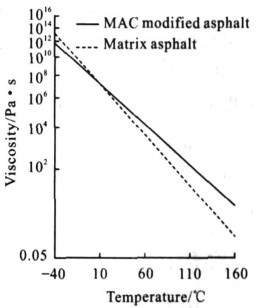Experimental research of MAC modified large stone porous asphalt mixture
-
摘要: 为了提高大粒径透水性沥青混合料(LSPM)基层的路用性能, 以MAC改性沥青作为LSPM结合料, 对MAC改性沥青、基质沥青和SBS改性沥青的性能进行了对比, 提出了MAC改性沥青LSPM高温稳定性、水稳定性、抗疲劳性、渗透性、抗反射裂缝性等路用性能要求, 并进行了MAC改性沥青LSPM材料组成设计、施工技术研究和试验路修筑。试验结果表明: MAC改性沥青LSPM空隙率为13%~18%, 沥青膜的厚度大于12μm, 模量为400~600MPa, 试验路通车2年后车辙量在4~8mm之间, 这表明MAC改性沥青LSPM具有较高的路用性能。Abstract: In order to improve the road performances of base course made of large stone porous asphalt mixture(LSPM), MAC(multigrade asphalt cement) modified asphalt was used in LSPM, the performances of matrix aphalt, MAC modified asphalt and SBS modified asphalt were compared, the material composition design, construction technology and the road performances of MAC modified LSPM, such as high-temperature stability, anti-fatigue property, permeability and anti-reflective crack property, were studied, and test roads were constructed. Test result shows that the porosity of LSPM is between 13% and 18%, its asphalt membrane is thicker than 12 μm, its modulous is between 400 and 600 MPa, the rut depth of test road opening to traffic for two years is between 4 and 8 mm. Obviously, MAC modified LSPM has better road performances. 4 tabs, 2 figs, 16 refs.
-
Key words:
- pavement material /
- LSPM /
- modified asphalt /
- road performance /
- material composition design /
- construction technology
-
表 1 Leakage test results of asphalts
Table 1. Leakage test results of asphalts

表 2 Technical requirements of modified asphalt
Table 2. Technical requirements of modified asphalt

表 3 Recommend gradations for LSPM
Table 3. Recommend gradations for LSPM

表 4 Design technical standards
Table 4. Design technical standards

-
[1] WANG Song-gen, FANGJian-guo, WANG Lin, et al. Study of the use of large-stone asphalt mixes in the flexible base courses to reinforce pavements[J]. China Journal of Highway and Transport, 2004, 17(3): 10-15. (in Chinese) https://oversea.cnki.net/kcms/detail/detail.aspx?dbcode=CJFD&dbname=CJFD2004&filename=ZGGL200403003 [2] KANDHAL P S. Large stone asphalt mixes: design and construction[R]. Washington DC: National Center for Asphalt Technology, 1990. [3] Transportation Research Board of the National Academies. Design and evaluation of large stone asphalt mixes[R]. Washington DC: Transportation Research Board of the National Academies, 1990. [4] KANDHAL P S. Design stone asphalt mixes to mini mize rutting[R]. Washington DC: National Center for Asphalt Technology, 1999. [5] ZHANG Yi-luo, HAO Pei-wen, XU Yong-ming. Study on performance of the previous bituminous mixture[J]. Journal of Xi an Highway University, 1999, 19(3): 14-17. (in Chinese) [6] XU Ai-li, WEI Lian-yu, ZHANG Wei-ping, et al. Mechanics analysis of large stone asphalt treated base[J]. Journal of Hebei University of Technology: Natural Science, 2007, 36(6): 118-121. (in Chinese) [7] MA Qing-lei, YANG Bin, CHEN Shuan-fa. Investigation ofreflective cracking and stress analysis for overlay structure withlarge-size asphalt macadam[J]. Journal of Xi an Univer-sity of Architecture and Technology, 2005, 37(1): 113-117. (in Chinese) [8] YANG Bin, CHEN Shuan-fa, MA Qing-lei, et al. Anti-cracking mechanismanalysis of cracking relief layer of extra coarse asphalt macadam[J]. Highway, 2005, 50(1): 76-80. (in Chinese) [9] LI Yu-zhi, LI U Feng, HUANG Yun-yong. Study on fatigue properties by test among SBS modified bitumen, multiphalte and heavy-traffic asphalt[J]. Highway, 2004, 49(6): 118-121. (in Chinese) [10] TANG Jun, LI Xiao-yong, WANG Wei-dong. Research on the pavement performance of SBS modified asphalt mixture and engineering practice[J]. Journal of Hefei University of Technology: Natural Science, 2004, 27(7): 800-813. (in Chinese) [11] WANG Shuang-jie, TAI Dian-cang. Evaluating indices for low-temperature performance of SBR modified asphalt binder[J]. Journal of Chang'an University: Natural Science Edition, 2007, 27(3): 29-34. (in Chinese) [12] ZHANG Zheng-qi, LI Ning-li, CHEN Hua-xin. Determining method of mixing and compaction temperatures for modified asphalt mixture[J]. Journal of Traffic and Transportation Engineering, 2007, 7(2): 40-44. (in Chinese) https://www.scientific.net/KEM.744.83 [13] ZHAO Ke, YUANJian-an. Research on the cohesiveness of polymer modified asphalt and aggregate[J]. China Journal of Highway and Transport, 2000, 13(2): 10-14. (in Chinese) https://oversea.cnki.net/kcms/detail/detail.aspx?dbcode=cjfd&dbname=cjfd2000&filename=ZGGL200002002 [14] JTJ018—97, specification of drainage design for highways[S]. (in Chinese) [15] JTJ032—94, technical specification for construction of high-way asphalt pavement[S]. (in Chinese) [16] JTJ058—2000, test methods of aggregate for highway engi-neering[S]. (in Chinese) -





 下载:
下载:


